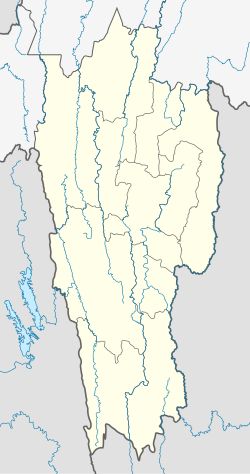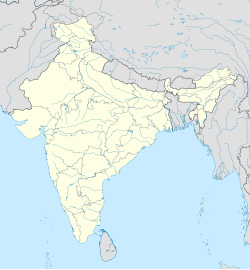Vaphai is a village at the extreme east of Champhai district of Mizoram.[2]
Vaphai
Ivaphai | |
|---|---|
village | |
| Nickname: Phaikhawpui | |
| Coordinates: 23°08′49″N 93°19′31″E / 23.146832°N 93.325227°E | |
| Country | India |
| State | Mizoram |
| District | Champhai |
| Block | Khawbung |
| Founded by | Mitinliana[citation needed] |
| Elevation | 1,733 m (5,686 ft) |
| Population (2011)[1] | |
• Total | 2,252 |
| Languages | |
| • Official | Mizo |
| Time zone | UTC+5:30 (IST) |
| PIN | 796321 |
| Vehicle registration | MZ |
| Coastline | 0 kilometres (0 mi) |
| Nearest city | Champhai |
| Sex ratio | 968 females per 1000 males ♂/♀[1] |
| Literacy | 98.06% |
| Website | thlangtlakmual |
Geography and location
editVaphai, with an average altitude of 5,686 feet (1,733 m) above sea level,[3] lies about 11 km east of Tehsil Main Town Khawbung.
Etymology
editIts original name was "Ivaphai", which literally means "Plains of the river Iva", referring to its original location in the river valley slightly west of its present location. The first syllable got dropped probably by elision in course of time. It is situated at an average altitude of 5,686 feet (1,733 m) above sea level.[3]
History
editThe village was established by Pu Mitinlianan in 1876 who started ruling the village for 45 years till his death in 1921. It was then ruled by Pu Chawnghleithanga in 1922 (1 year), who then passed it on to his son Pu Tlangtinchhuma who ruled till 1937 (14 years). The last chieftainship was held by Pu Lalrokhama (17 years) until the abolition of chieftainship in 1954.[4]
Demographics
editAccording to the 2011 census of India, Vaphai has 454 households. The effective literacy rate (i.e. the literacy rate of population excluding children aged 6 and below) is 95.25%.[1]
| Total | Male | Female | |
|---|---|---|---|
| Population | 2252 | 1144 | 1108 |
| Children aged below 6 years | 419 | 198 | 221 |
| Scheduled caste | 0 | 0 | 0 |
| Scheduled tribe | 2203 | 1109 | 1094 |
| Literates | 1746 | 911 | 835 |
| Workers (all) | 1123 | 621 | 502 |
| Main workers (total) | 1108 | 618 | 490 |
| Main workers: Cultivators | 821 | 431 | 390 |
| Main workers: Agricultural labourers | 109 | 58 | 51 |
| Main workers: Household industry workers | 9 | 7 | 2 |
| Main workers: Other | 169 | 122 | 47 |
| Marginal workers (total) | 15 | 3 | 12 |
| Marginal workers: Cultivators | 5 | 1 | 4 |
| Marginal workers: Agricultural labourers | 3 | 1 | 2 |
| Marginal workers: Household industry workers | 0 | 0 | 0 |
| Marginal workers: Others | 7 | 1 | 6 |
| Non-workers | 1129 | 523 | 606 |
Tourism
editSince the Mizos moved into Mizoram from the east, most historical monuments and places of cultural importance are to be found in eastern Mizoram and Burma.[5]
Ṭan tláng, lit. Ṭan mountain, with a height of 6,027 feet (1,837 m) is the fifth-tallest mountain in Mizoram.[6]
Economy and border haat trade
editVaphai (Saikhumphai) is one of the 4 Border Haats (markets) in Mizoram, others being at Sangau (Pangkhua), Hnahlan and Zote, all of which boost the local trade and economy.[7]
Transport and connectivity
editZokhawthar (88 km north) provides connectivity to India–Myanmar–Thailand Trilateral Highway (IMT),[8] and Asian Highway Network and Asian Highway 1 (AH1).[9]
See also
editReferences
edit- ^ a b c d "District Census Handbook - Champhai" (PDF). 2011 Census of India. Directorate of Census Operations, Mizoram. Retrieved 22 August 2015.
- ^ "Profile of Vaphai village". Profile of villages within Khawbung RD block. Khawbung Rural Development Block. 2011. Retrieved 19 June 2012.
- ^ a b Rintluanga Pachuau (27 August 2015). "Mizoram: A Study in Comprehensive Geography".
- ^ ""Vaphai" history". 8 December 2012.
- ^ Lalthangliana, B. (1980). History of Mizo in Burma. Zawlbuk Agencies. Retrieved 9 December 2018.
- ^ "Hills in Mizoram". Retrieved 27 August 2015.
- ^ Outlook India India, Myanmar likely to set up four Border Haats, Outlook India, 20 Aug 2019.
- ^ The Role of BIMSTEC in Revitalising India’s Northeast, ORF, 23 Jun 2021.
- ^ New road, rail links to make Manipur gateway to SE Asia: CM, The Hindu, November 08, 2018.

